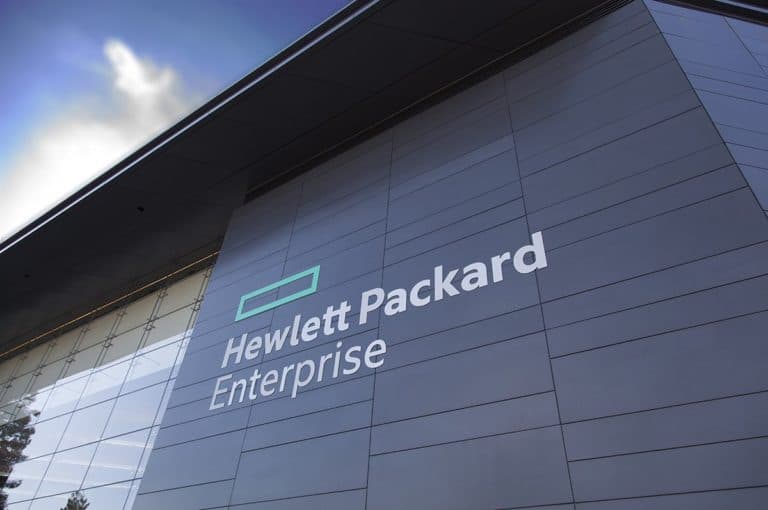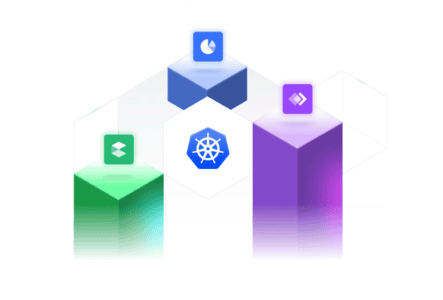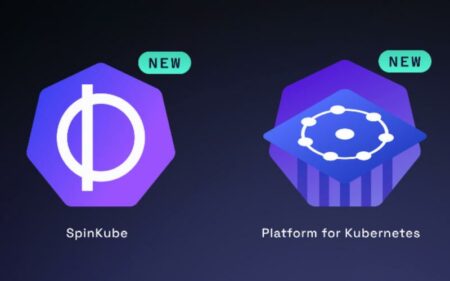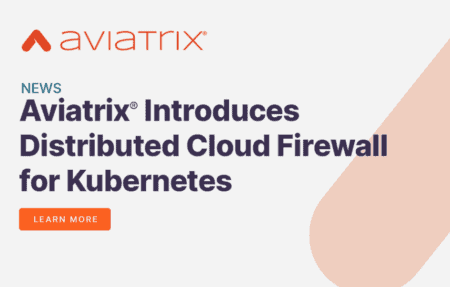Many companies see the value of containers for their applications. Kubernetes is the most widely used orchestration platform for this purpose. HPE is now also coming up with its own Kubernetes solution. Own technology enables both legacy- (non-cloud-native) and cloud-native applications to be brought to any desired environment, fully automated: on-premise, virtual environments and public clouds, or even to the edge.
More and more companies are working on their digital transition, often out of a desire on the business side, especially towards cloud environments. Many of these pathways are slow or fail even because companies discover that developing and rolling out new, often ‘cloud-ready’, applications in a distributed infrastructure takes a lot of time and money.
They also discover that certain existing or legacy applications cannot be migrated to the cloud. So they have a lot of trouble landing their applications and associated workloads in the right place in the right environment, and keeping track of them.
Containers and Cube Networks
Container technology is the solution for this, nowadays. With containers, companies can develop, test and bring applications into production faster. In addition, the use of containers avoids the high price that VMs bring with them, among other things because of the need to pay per unrolled VM and also for the OS installed per VM. After all, containers share the underlying OS and physical resources such as computing power, storage and network so that they can be used more efficiently.
With the help of the open-source orchestration platform for containers Kubernetes, companies can automatically scale all these applications and workloads, roll them out within the various (cloud) environments and manage them at the same time.
HPE Container Platform
It goes without saying that the current popularity of Kubernetes has not escaped the large software vendors, and they have been working for a long time on optimising their solutions and applications for this technology. The large business infrastructure specialists, who nowadays focus their solutions and applications on hybrid and public cloud environments, now also seem to embrace Kubernetes.
So does HPE, which recently announced its Kubernetes-based solution HPE Container Platform. Especially as customer demand for enterprise-ready container and orchestration technology is increasing enormously, Enterprise Architect Marcel de Bont at HPE Netherlands announces.
The fact that HPE is only now coming up with a Kubernetes platform has to do with the fact that it was first decided which container technology, in this case Docker, and orchestration platform, Kubernetes, would become the common ‘standard’.
Another reason is that the added value provided by HPE to its Kubernetes platform comes from two recently acquired parties; BlueData and MapR. These two companies specialise in the automated provision of analytics and machine learning applications (BlueData) and distributed file systems for large amounts of data (MapR). It took some time before the technology of these companies was fully integrated into the HPE portfolio and available for other applications.
Basic version of Kubernetes and proprietary technology
Concretely, the now presented HPE Container Platform consists of the ‘vanilla’ basic version of Kubernetes. HPE has added its own ‘secret sauce’ to its own technology and solutions.
A ‘proprietary’ Kubernetes version has not been chosen because HPE wants to continue to offer its customers the standard updates of the container orchestration platform now and in the future. As improvements are being implemented at a fast pace, it is, therefore, more efficient to do this in this way than to adapt an ‘own version’ over and over again. So, customers always have the latest Kubernetes version, according to De Bont.
Technology of BlueData
The added value that HPE offers with its container platform lies in the added value of the Blueata and MapR technology.
For BlueData, the HPE Container Platform uses the Elastic Private Instant Clusters (EPIC) platform. This technology can, in the past for Hadoop-based data analytics applications such as Cloudera or Kafka, quickly create container environments and roll them out to various environments. Not only to public cloud environments but also to virtual environments (whether or not based on VMware), on-premise or even the edge. This Blue Data platform also offers a single pane of glass for handling management tasks.
Within the HPE Container Platform, in addition to the standard Kubernetes platform, BlueData technology, including the central management tool, forms the heart of the solution. This is especially true because this technology ensures that non-cloud-native applications can also run on Kubernetes. In this way, they find their way further into the infrastructure. Within the HPE solution, BlueData technology is the so-called ‘control plane’ for container management. Of course, Kubernetes does the orchestration native.
Data tapping possible
Another nice feature that BlueData brings to the HPE container platform is the ability to create data taps instead of copying entire data sets. This is especially useful for customers who work a lot with large data models or analytics sets.
The tapping technology makes it possible to extract the data you need directly from the general data lake using a so-called ‘pointer’ or connector. According to De Bont, this prevents the transfer of large amounts of data for analytics and, of course, the time and costs involved.
Other technology used by BlueData in the HPE Container Platform include solutions for artificial intelligence (AI) and machine learning.
Persistent container storage and distributed file system technology
The HPE Container Platform combines BlueData with MapR technology. The latter added technology mainly includes pre-integrated persistent container storage technology. With this technology, the contents of containers can be stored, used, disposed of or reused again.
The BlueData platform already offered persistent container storage, which was initially developed as storage technology for the realisation of stateful containers and persistent storage for analytics purposes of large data sets. The HPE Container platform adds MapR’s distributed file system to create a single namespace file system that can extend from edge to on-premise and cloud.
The HPE Container Platform automates the provision of complete analytics toolsets, data pipelines and development environments. Think of combinations of databases such as MongoDB, data analytics with Cloudera, Spark and Kafka, AI and ML applications such as H2O and TensorFlow and code such as Java, .NET and php. Other integrated CI/CD solutions and combinations are Jenkins, GitLab and Bitbucket. And, of course, custom applications.
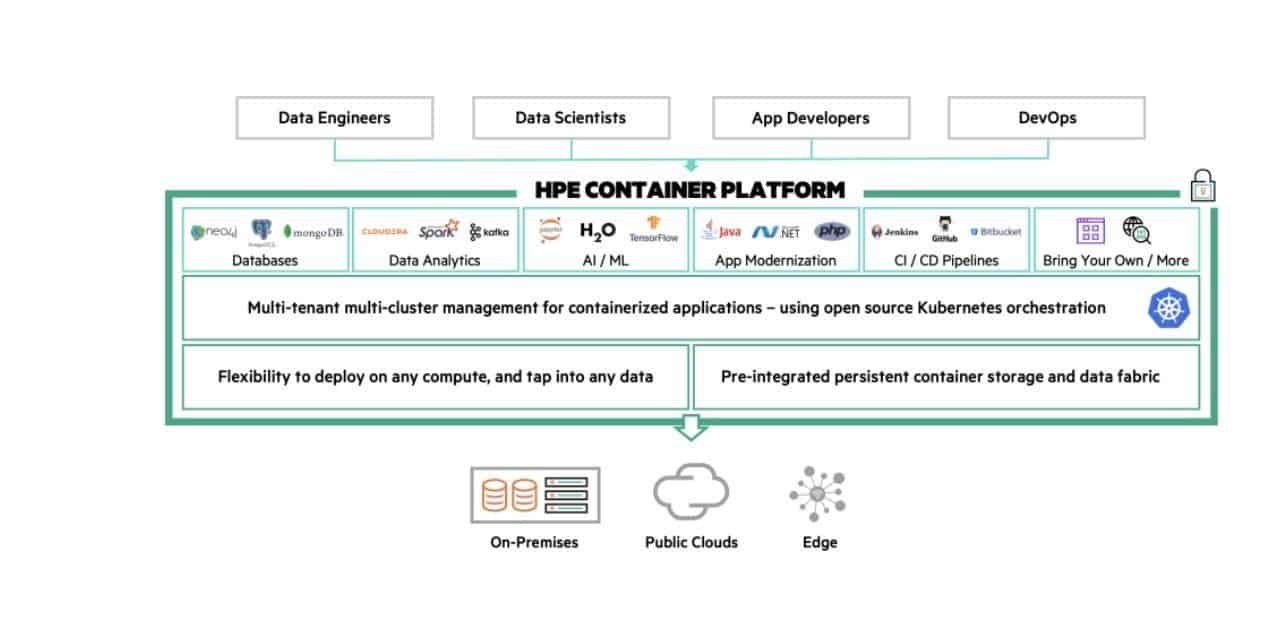
From what do customers benefit?
The HPE Container Platform offers customers a wide range of possibilities. The platform allows them to automate and accelerate the rollout and multi-tenant multi-cluster management of containerised applications, both non-cloud-native (or legacy) and cloud-native. In particular, this offers opportunities for legacy applications that cannot or hardly benefit from the cloud without refactoring and thus a new development path.
Customers with the container platform based on Kubernetes and the added proprietary technology can take their applications wherever they want, whether this is on-premise, in virtualised environments and the various public clouds such as AWS, Google Cloud and Azure. And even to edge environments.
Also, developers can now further increase productivity and more easily release the latest releases of their applications and code with the features that Kubernetes offers them. These include the deployment capabilities of the orchestration platform and multi-cluster management.
Furthermore, the HPE Container Platform ensures that customers have access to the best security applications, performance and reliability at a lower cost. This includes the use of containers in bare metal configurations and the availability of data persistence.
Suitable for data-intensive businesses
Potential customers are, mainly, companies that work with large data flows and want to apply analytics on a large scale. These are mainly companies that have a high dynamic in terms of numbers of workloads, but also, for example, do a lot of predictive analytics. These include financial institutions, healthcare and university institutions.
According to De Bont, these companies or sectors are typical examples of real use cases. The use cases for the container platform are those companies and sectors that are increasingly looking at data and want to know what the value of this data is. The dynamics of these companies lie in experimenting with machine learning models and data sets, and the need for collaborative environments to be able to program and share data models with each other.
The HPE Container Platform focuses in particular on the maximum facilitation of data analysts, data engineers, data scientists, application developers and, of course, DevOps specialists. These groups would like to have an environment quickly available for experimentation, testing, development and acceptance and not be busy installing data pipelines or development lines themselves every time.
Interesting development
With its own container platform, HPE is taking a new step in perfecting its portfolio, enabling customers to develop, deploy and manage a fully automated infrastructure and all related applications easily, quickly, at a lower cost and not unimportantly. Customers with high data-intensive workloads in particular benefit from the HPE Container Platform. This is due to the important technological innovations of BlueData and MapR that are added to the basic Kubernetes version.
The HPE Container Platform is scheduled for a general release in the spring of 2020. Naturally, it will also be available via HPE Greenlake so that customers can be completely relieved.
Undoubtedly, the platform will continue to evolve, and more functionality will be added in the near future. We will keep an eye on it.
